Archive for the 'Fruit' Category
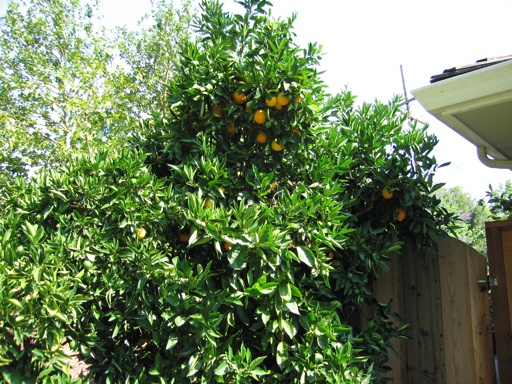
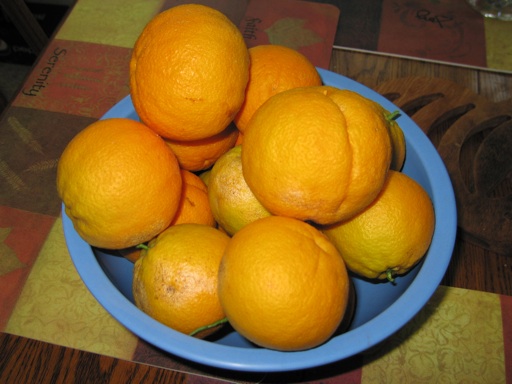

The house we live in came with mature valencia and navel orange bushes. The navel oranges ripen in the spring. The valencia oranges ripen in the summer, right in the middle of the fruit season for so many other plants we have growing in our yard. Because we are so busy eating other fruits, we often leave many of our valencia oranges on the bush for months after they are ready to pick. Valencia oranges can hang on the branches for months after they are ripe without losing quality or rotting. Sometimes I leave some of the fruit on the bush until October early November.
Our valencia bush typically produces over 100 fruits each year. This year it has about 200 oranges. They are good for eating fresh, although they are not as tasty and sweet as the navel oranges. We use most of our valencias to make fresh squeezed orange juice, which is so good. I usually add a teaspoon or two of sugar to each glass to make it extra sweet. I squeezed about 8 oranges to make the two glasses in the bottom picture.
Oranges are tricky plants to get established. In order to get oranges to thrive, they need lots of nitrogen rich fertilizer, applied in the late winter and spring. And in my opinion, they also need regular watering.
I have planted several oranges, because I wanted to try new varieties, and because I wanted another navel. Most of the young oranges I planted have died. Several of the young oranges I planted died as soon as their root balls dried out in the summer. The mature oranges we have are better able to tolerate dry periods than the recently planted oranges. My theory on oranges is to keep them well-fed and well-watered, just not saturated or water logged. I have read many posts on other sites claiming that oranges like to dry out between waterings. That technique has never worked for me.
August 09 2009 | Oranges | Comments Off on Valencia Orange Juice
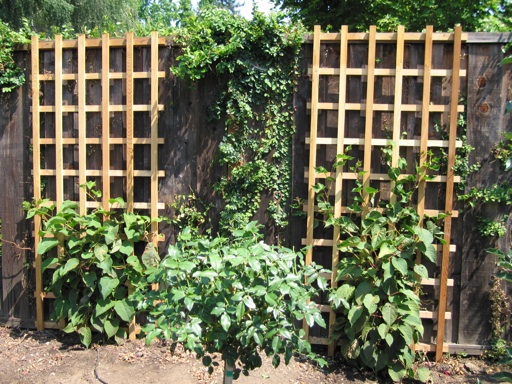
I planted male and female kiwifruit plants along the fence in our backyard last spring. I like the taste of store bought kiwifruit, and I thought it would be fun to grow our own. I have also heard that home grown kiwifruit tastes better than the store bought ones.
I selected a female kiwifruit variety called Vincent, because that was the only variety being sold in our local nurseries, and a male variety selected to pollinate a Vincent female. You need to have a male plant to pollinate the female, or the female won’t set fruit.
I used to think that kiwifruit was a tropical plant that required a tropical climate to grow and produce fruit. I found out only last year that it is a temperate climate plant that requires at least a few hundred hours of chill (i.e., below 45 degrees F) each winter to stimulate fruit production.
After doing some research into kiwifruit, I have learned that it is a vigorous grower that requires a sturdy support system for its vines and fruits. Apparently, a mature female kiwifruit plant can produce hundreds of pounds of fruit each year. Most commercial growers use T-shaped trellises or pergolas to support kiwifruits. Many home growers train kiwifruits to grow up an arbor.
I decided instead to use a smaller support system that would take up less space than an arbor or T-trellis. Last weekend, I nailed one wooden grid-shaped trellis to our fence behind each kiwi plant, as shown in this picture. The male plant is on the left, and the female plant is on the right. My plan is to prune both plants severely a few times a year to keep them within the bounds of these support structures.
I don’t want to get hundreds of pounds of fruit each year. About 20-30 pounds would be enough. It seems that these trellises would be large enough to support about that much fruit. I am just hoping that it will be manageable to keep the vines confined within this area as they mature.
August 09 2009 | Kiwifruit | Comments Off on Kiwifruit on Trellis
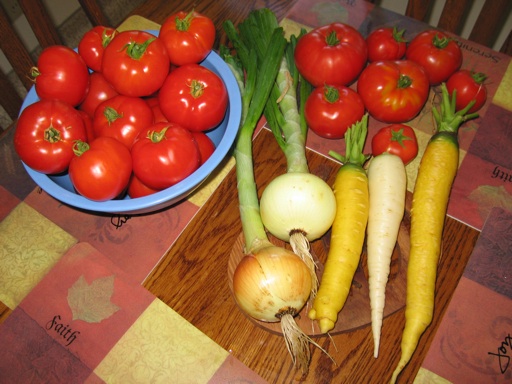
As shown in this picture, we harvested yellow and white carrots, walla walla onions, a bunch of big beef and early girl tomatoes from our vegetable garden today. We are making homemade pizza sauce, minestrone soup, and vegetable lasagna with our harvest. We saved money by growing many of the ingredients for these recipes ourselves, and all of these vegetables were easy to grow. Beyond planting in the spring and then harvesting months later, maintaining our vegetable garden did not require a lot of effort.
The automatic watering system in our vegetable garden saves us the trouble of having to water regularly. I fertilized multiple times after planting. But once the plants started growing rapidly, I figured there wasn’t a need for much additional fertilizer. And I only needed to do a little bit of weeding. I think that the weeds just didn’t get a chance to grow, because I planted the vegetables relatively close together. Once the vegetable plants started to grow together, there wasn’t much sunlight to stimulate weed growth in between them.
I just planted another set of carrot seeds. July and August is the time to plant carrot seeds for an autumn and winter harvest. One nice thing about carrots is that they hold well in the ground after they reach maturity without rotting or losing quality. That means you can leave them in the ground for months until you are ready to harvest them.
July 26 2009 | Carrots and Onions and Tomatoes | Comments Off on Summer Harvest
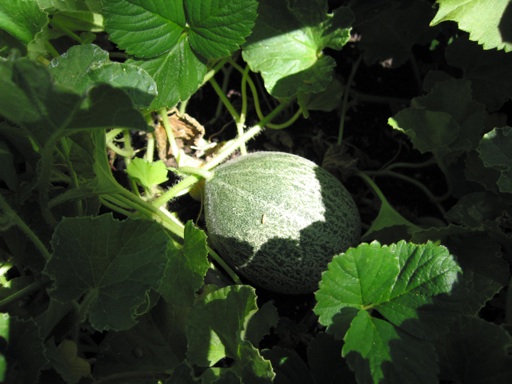
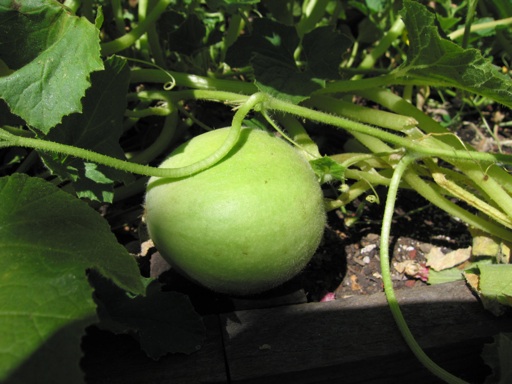
Last year, I experimented with growing cantaloupes. Although a few cantaloupes developed (one nearly grocery stored size), they weren’t edible, because they didn’t develop any sweetness. Since then, I have read that melons need a lot of summer warmth to sweeten up properly. They are grown successfully in hot summer climates where the high temperatures regularly exceed 90 degrees F. In our area, the summer highs average around 80 degrees F.
This year, I planted a type of cantaloupe (i.e., muskmelon) called Hale’s Best. I have heard that this particular variety of cantaloupe is more likely to ripen in a mild summer climate. I also planted the cantaloupes about 6 weeks earlier than last year to give them a head start. I planted seeds in early April and transplants from a nursery in mid-April to see which would grow better. Both are doing well so far.
A few cantaloupes are already developing on the vines (see first picture). The melons seem to be developing at least few weeks earlier that last year’s melons. I can’t wait to see if they ripen this time. I am hoping that planting them earlier will give them enough time to reach full sweetness. Home grown melons are supposed to be far more sweet and flavorful than the typical grocery store melon.
I also planted honey dew melons by seed. I selected a variety called Sweet Delight that was being sold at a local nursery. I know that honey dew melons may need even more heat than muskmelons to ripen fully. But I decided that it would be fun to try at least once.
I set out several honey dew and cantaloupe seeds in March. Birds ate most of those soon after they sprouted. I then planted a second round of honey dew and cantaloupe seeds a few weeks later in early April. The second time, I put bird netting over the seedlings. Most of the seeds in this second batch managed to sprout and grow into vines that are now producing small melons. The second picture shows one of the honey dew melons on the vines.
July 25 2009 | Melons | Comments Off on Another Try with Melons
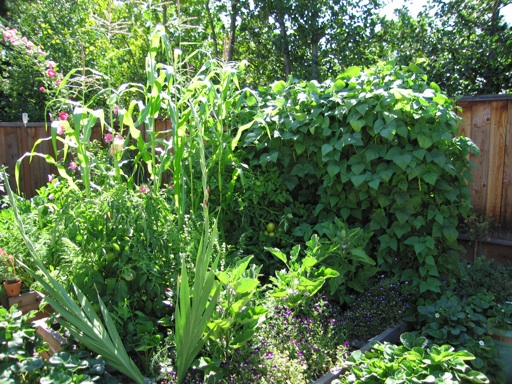
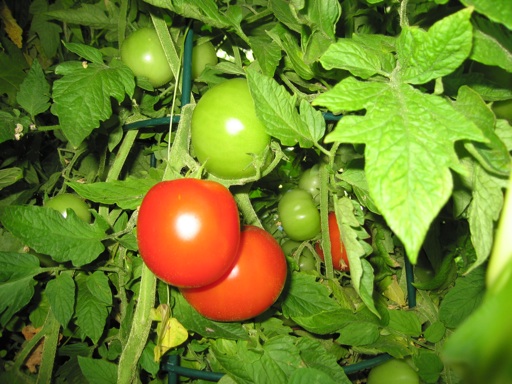
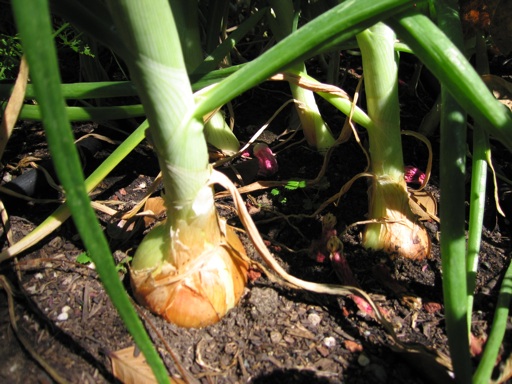
We have been growing vegetables in two 6′ x 7′ raised beds since last summer. In these two small beds, we are growing several different types of fruits and vegetables including peppers, eggplant, zucchini, green beans, tomatoes, corn, carrots, onions, cantaloupe, and honey dew.
Our most successful plants so far are the green beans and zucchinis. They are producing more green beans and zucchinis than we can eat. Only a few of the tomatoes on our two tomato plants are have ripened so far (see second picture), but there are dozens of green tomatoes hanging on the vines.
Several of our carrots and onions are just about ready to harvest. The third picture shows some of the walla walla onions we are growing this season. Our corn stalks have reached their maximum height and are now starting to grow small corn ears.
Our eggplants and peppers are growing several small fruits. Although the peppers have not grown very much since I planted them in April. They seem to be getting crowded by the beans, carrots, and tomatoes growing next to them. One of the problems with growing so many different types of plants in a small area is that the slow growing plants like peppers and eggplant tends to get crowded by the faster growing plants. Next year, I may try to plant the slower growing plants together in one bed and the faster growing plants in the other bed.
I haven’t fertilized most of the plants in our vegetable garden since mid-May. I was fertilizing them with water soluble fertilizer for about the first 6 six weeks after planting. After that, most of the vegetables started growing so fast that I decided to stop the fertilizing. I have only been continuing to fertilize the eggplants and peppers in an attempt to get them to grow more.
I have also been fertilizing our strawberries about once a week. I know that sounds like a lot of fertilizer, but they have been producing strawberries continuously since early May. They show no signs of slowing down their fruit production yet. I have been harvesting a small bowl full of berries every few days for over two months. I attribute the huge production of berries to all the fertilizer. Last year, they stopped producing berries in early June. But as soon as I started fertilizing them, they begin to produce berries again.
Our strawberries are growing in pots around the raised beds, which makes it easy to pick them. Strawberries tend to rot quickly when the fruits are lying directly on damp soil. The berries mostly hang over the edges of the pots, so the berries stay dry.
July 12 2009 | Onions and Strawberries and Tomatoes and Vegetables | Comments Off on Vegetable Garden Update
« Prev - Next »









